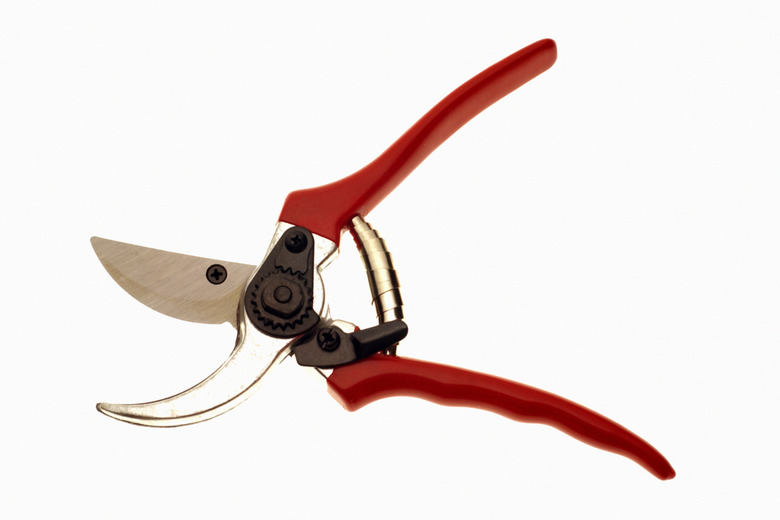How To Trim A Bottle Brush Tree
The bottlebrush tree (Callistemon spp.) gets its name for its large, showy flowers that look just like a baby bottlebrush, something with which any mother is all too familiar. Though useless for cleaning up after a feeding, these plants do make for an impressive showpiece in the garden. While the genus does include some true tree forms, most bottlebrush trees are actually shrubs pruned as standards. All but one strong shoot are removed, and it is pruned back repeatedly to make a bushy canopy. These specimens require summer trimming to maintain the tree form and control errant branches.
Step 1
Step 1
Remove all suckers that compete with the main trunk or trunks, as well as any shoots that grow along the trunk, below the canopy. Suckers are upright shoots that sprout from the roots and if not cut back to the ground, will develop into full, upright branches that compete with the main plant for space, water and nutrients. While bottlebrush trees are frequently trained to only one main trunk, you might have a multi-stemmed tree, usually with an odd number of upright branches.
- The bottlebrush tree (Callistemon spp.)
- Remove all suckers that compete with the main trunk or trunks, as well as any shoots that grow along the trunk, below the canopy.
Step 2
Step 2
Prune out all dead, diseased and broken branches, not only during the main summer pruning session, but as they occur throughout the year. Cut back the the nearest lateral branch or the point of origin on the parent branch. Dead branches might be the result of disease and broken branches invite disease, so it's best to prune all these branches about 6 inches into unaffected wood.
Step 3
Step 3
Eliminate any rubbing or crossing branches. When selecting which of two rubbing branches to remove, select the strongest, healthiest branch. In order to establish and maintain a healthy, full canopy, you want to trim the tree to leave only strong, well-spaced branches with wide angles that point toward the outside of the canopy. Cut the weaker, undesired branch back to about 1/4 inch above the branch union.
- Prune out all dead, diseased and broken branches, not only during the main summer pruning session, but as they occur throughout the year.
- Dead branches might be the result of disease and broken branches invite disease, so it's best to prune all these branches about 6 inches into unaffected wood.
Step 4
Step 4
Deadhead the flowers as they begin to fade in effort to prolong the blooming period. Clip the stems back to the nearest leaf set behind the expiring flowers. Bottlebrush trees bloom most prolifically throughout summer, but might bloom intermittently throughout the year in the frost-free climates of USDA zones 9 through 11.
Step 5
Step 5
Clip back branches to shape the plant and control long branch growth that looks out of place. Only prune the new growth tips — never prune into the old wood toward the interior of the bottlebrush tree because the branches are unlikely to grow back. When you prune only the tips, you encourage new branching for full tree canopy.
Step 6
Step 6
Cut back the upper branches to reduce the height of the canopy; cut the uppermost branches back to a connecting branch that measures at least one-third the diameter of the branch you're cutting. While the tree will eventually fill out the open space from this pruning, this type of crown pruning should be limited. If you find you must frequently prune to reduce crown height, it might be best to simply replace the bottlebrush tree with a smaller cultivar.
- Deadhead the flowers as they begin to fade in effort to prolong the blooming period.
- Only prune the new growth tips — never prune into the old wood toward the interior of the bottlebrush tree because the branches are unlikely to grow back.
Tip
Callistemon species are hardy in U.S. Department of Agriculture plant hardiness zones 8 through 11, but the exact zones within that range varies among the 40 different species. The most common specimen, scarlet or lemon bottlebrush (Callistemon citrinus) grows in USDA zones 8 through 11, while weeping bottlebrush (Callistemon viminalis) is hardy in USDA zones 9 through 11.
Tip
Use bypass pruners to cut branches up to 1/2 inch in diameter; cut branches up to 1 1/2 inches in diameter with lopping shears; use a pruning saw to remove branches large than 1 1/2 inches. Disinfect all pruning tools before use and after cutting diseased wood, using a solution of bleach diluted at a rate of 1 part chlorine bleach to 9 parts water.
Things Needed
- Chlorine bleach
- Bypass pruners
- Lopping Shears
- Pruning saw
References
- Missouri Botanical Garden: Callistemon Citrinus
- Monrovia: Scarlet Bottlebrush
- Cal Poly Urban Forest Ecosystems Institute: Lemon Bottlebrush
- University of Florida IFAS Extension: Callistemon Citrinus
- Fine Gardening: Genus Callistemon (Bottlebrush)
- Floridata: Callistemon Viminalis
- Australian National Herbarium: Bottlebrush — Genus Callistemon
- Las Vegas Review-Journal: Bottlebrush Can Survive with Little Water
